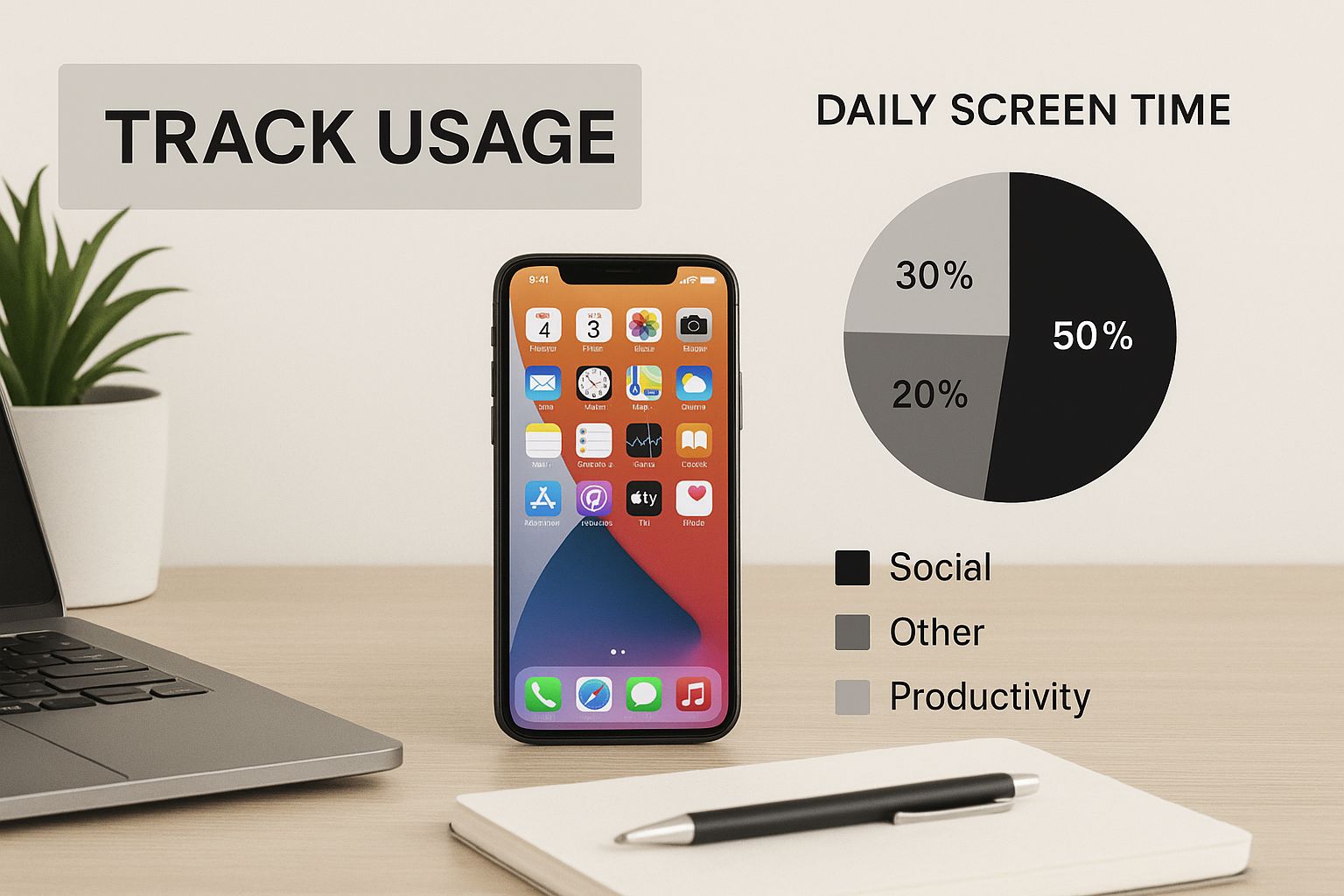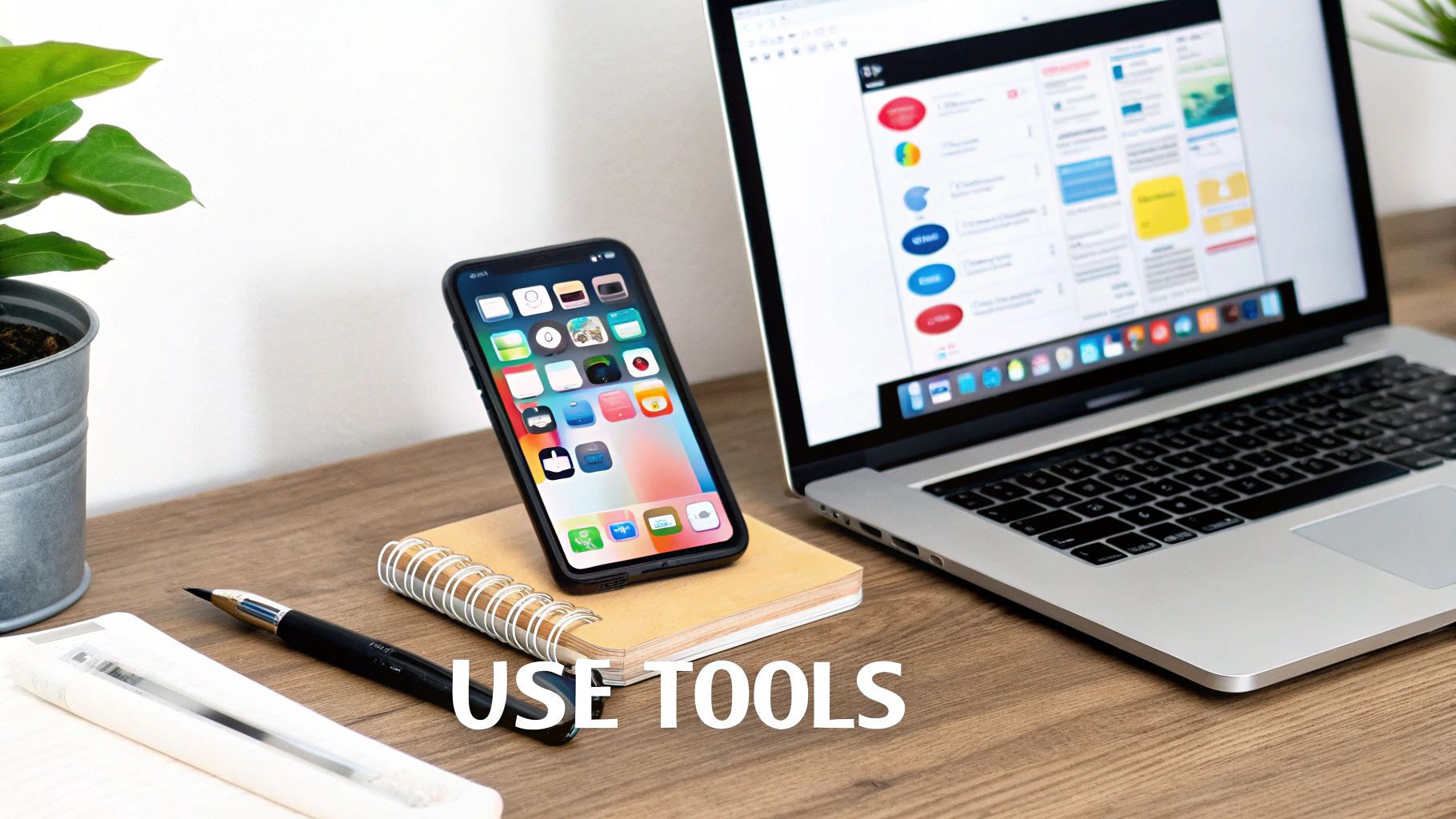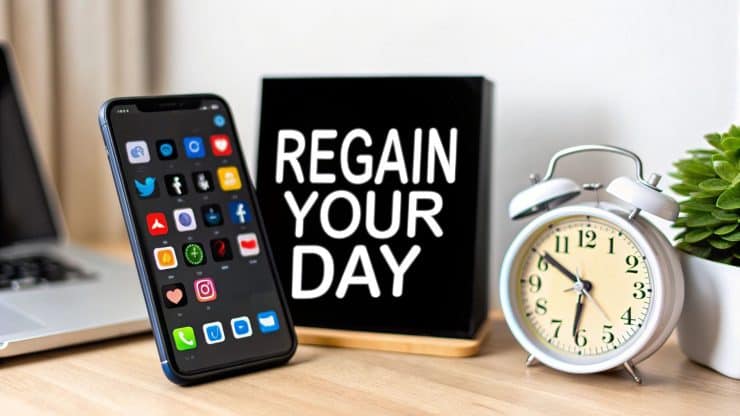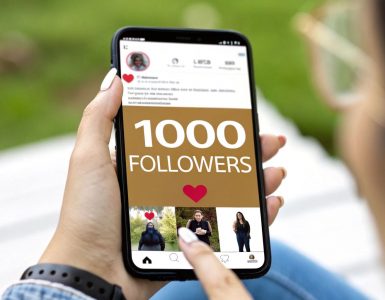The Real Cost of Social Media on Your Daily Schedule
Think about your average day. How much time do you really spend scrolling through social media feeds? It's likely more than you think. Social media platforms are designed to be addictive, using psychological tricks to keep you hooked. This makes traditional time management methods often ineffective.
The Psychology of Endless Scrolling
These platforms use several tactics to hold our attention. The infinite scroll, for instance, provides a never-ending stream of content, removing any natural stopping points. Notifications create a fear of missing out (FOMO), making us check our phones constantly. And variable rewards, much like a slot machine, keep us engaged with the unpredictable nature of likes and comments. Willpower alone isn't enough. You need a strategy.
Time Wasted vs. Time Well Spent
Excessive social media use can severely impact productivity, taking time away from essential tasks. Imagine spending hours on Instagram only to realize you haven't started that important project. It's not just about work; it's about sacrificing time for hobbies, relationships, and self-care. Instead of connecting with loved ones, we're often glued to our screens. This constant digital connection can ironically lead to feelings of disconnection and overwhelm.
The overall impact on our schedules is substantial. As of early 2025, internet users globally spend an average of 2 hours and 21 to 24 minutes per day on social media. That's approximately 15% of our waking hours dedicated to these platforms. Find more detailed statistics here. This figure has remained fairly consistent in recent years, highlighting social media's strong hold on our attention. This emphasizes the need for mindful social media management to regain control of our time.
Smart Time Blocking Strategies For Social Media Success
Social media management is about maximizing impact and minimizing distractions. It's about using social media strategically, not letting it control your time. This involves structuring your social media activities within specific timeframes, rather than letting them disrupt your productive work. This section explores practical time blocking techniques to reshape your social media habits and boost your overall productivity.
Understanding Time Blocking
Time blocking involves allocating specific times for specific tasks, similar to scheduling appointments. For social media, this means designating specific time windows for checking feeds and engaging with content. This prevents aimless scrolling and helps maintain focus on other important tasks.

The infographic above visually represents social media usage tracking. Monitoring your time on different platforms helps identify where you might be losing valuable time. This awareness is the first step toward effective time blocking.
Micro-Sessions vs. Dedicated Breaks
There are two main approaches to time blocking for social media: micro-sessions and dedicated breaks. Micro-sessions are short bursts of activity (5-10 minutes) scattered throughout the day. These are useful for staying updated or responding to messages. However, if not carefully managed, they can be disruptive. Dedicated breaks, conversely, allot longer periods (30 minutes to an hour) at designated times. This promotes more focused interaction and reduces the urge to constantly check your phone.
Crafting Your Ideal Schedule
The best time blocking strategy depends on individual needs and work style. If you frequently switch between tasks, dedicated breaks might be better. If your work demands regular online interaction, shorter, more frequent micro-sessions could be more effective. Consider exploring resources like How to master Twitter for customer acquisition or Bizness Socialajos Tiklos Iconcept Celvedis to better understand how social media integrates with your work. Experiment to find what works for you. For example, scheduling social media breaks as a reward after completing a major task can be motivating.
To help you visualize different scheduling options, let's look at a comparison table:
The following table offers a comparison of different time blocking approaches for various lifestyle and work patterns. It highlights the key differences and benefits of each schedule type to help you choose the one that best suits your needs.
| Schedule Type | Social Media Windows | Protected Work Hours | Best For |
|---|---|---|---|
| Micro-Sessions | Multiple 5-10 minute blocks throughout the day | Flexible, interspersed with work | Individuals needing frequent updates, fast-paced environments |
| Dedicated Breaks | 2-3 designated 30-60 minute blocks | Clearly defined, longer periods of focused work | Individuals preferring deeper engagement, minimized distractions |
| Task-Based Breaks | Short breaks after completing specific tasks | Variable, dependent on task completion | Individuals seeking motivation, project-based work |
This table provides a framework for thinking about how to structure your social media time. Remember that the best approach is one that you can consistently follow and that aligns with your work flow.
Transitioning Smoothly
Successful time blocking relies on smooth transitions. Avoid abruptly switching between work and social media. Create buffer zones. Before a social media break, take a moment to finish your current task and mentally prepare for a change in focus. Similarly, after your break, ease back into work with a brief review of your next task. This helps maintain momentum and avoid feeling disoriented. By implementing these strategies, you can transform social media from a distraction into a productivity tool that complements your workflow and contributes to your success.
Platform-Specific Management That Actually Works
Social media time management isn't a one-size-fits-all solution. Each platform boasts a unique design and algorithms specifically crafted to keep you engaged. This necessitates a tailored strategy for each. Let's explore how to effectively manage your time across different social media platforms.
Understanding Platform Nuances
Recognizing the distinct characteristics of each platform is the first step toward effective time management. Instagram, with its visual focus, encourages passive scrolling. Twitter, a hub for real-time updates, thrives on quick interactions. LinkedIn, professionally oriented, requires more focused engagement. For a deeper dive into social media planning, check out this helpful resource: How to master social media planning.
Optimizing Platform Settings
Most platforms offer customizable settings to control notifications and limit distractions. On Instagram, you can mute specific accounts or keywords to reduce unwanted noise. Twitter allows you to tailor notifications, receiving alerts only from key accounts. On LinkedIn, customizing your feed preferences ensures you see relevant content, minimizing time wasted on irrelevant posts. These small tweaks can significantly impact your overall time spent on each platform.
Managing Platform-Switching Behavior
Constantly switching between platforms can fragment your attention and hinder productivity. A useful strategy is dedicating specific times for each platform. This might involve checking Instagram during lunch, responding to LinkedIn messages in the afternoon, and browsing Twitter during your commute. This structured approach creates intentional boundaries and minimizes the urge to constantly switch apps.
Prioritizing Platforms Based on Goals
Not all platforms serve the same purpose. Identifying which platforms align with your personal and professional goals is crucial. If you're a visual artist, Instagram might be your primary focus. For journalists, Twitter might be the go-to for breaking news. By implementing platform-specific strategies that align with your time management goals, you can dominate social media like a pro. This focused approach optimizes your time and energy allocation.
Maintaining Focus Within Each Platform
Even within a single platform, distractions are plentiful. Setting clear intentions before logging in can help you maintain focus. Are you checking Instagram for inspiration or to connect with friends? Are you using Twitter for news updates or to engage in a specific conversation? This intentionality minimizes aimless scrolling and maximizes the value you get from each platform. As of 2025, Facebook has 3.065 billion monthly active users, making it the largest platform globally. Yet, the average daily time spent on Facebook is only 31-32 minutes, significantly less than the overall social media average. This data highlights how user engagement is distributed across various platforms, with younger demographics often favoring platforms like TikTok and Snapchat. For more detailed social media statistics, see here. Understanding these trends and your own platform preferences can further refine your social media time management strategy.
Building Digital Boundaries That Stick
Mastering social media time management involves more than just scheduling posts. It requires establishing digital boundaries to protect your time and attention. This means controlling when and how you interact with social media platforms throughout the day. Think of it like building a fence around your focus, permitting social media access only at designated times.
Advanced Notification Strategies
Notifications are designed to interrupt. They're the digital equivalent of someone constantly tapping you on the shoulder. However, you can regain control. Most platforms, like Instagram, offer granular notification customization. You can choose to receive notifications only for direct messages, or perhaps just for posts from close friends. This minimizes distractions while staying connected to what’s important.
Also, consider using your device's Do Not Disturb mode during focused work. This creates a temporary digital shield against all notifications.
App Management and Physical Boundaries
Your phone's physical location significantly influences its accessibility. Out of sight, out of mind. Try placing your phone in a drawer or another room while working. This creates a physical barrier that reduces the urge to mindlessly scroll.
Some people find success with app blockers or website blockers. These tools temporarily restrict access to distracting websites and apps, creating technology-free zones in your digital life.
Screen Time Controls and Social Pressure
Most smartphones include built-in screen time controls. Use them. Set daily limits for social media apps to create a hard stop for your scrolling. This can be surprisingly effective in curbing excessive use.

Establishing digital boundaries can sometimes invite social pressure. Friends might question your reduced availability, or you may experience FOMO (fear of missing out). Learn more in our article about How to master social media automation. Prepare simple responses to explain your boundaries without over-justifying them. "I'm focusing on work right now, but I'll catch up later," is polite yet firm.
Maintaining Balance and Handling FOMO
Reducing reactive scrolling doesn't mean disconnecting entirely. It's about finding balance. Schedule dedicated time for meaningful social interactions, perhaps setting aside an hour each evening to connect with friends online without the constant pressure of notifications.
Reframing your perspective on FOMO can also help. The constant stream of social media updates often presents a curated, and often unrealistic, view of others' lives. Recognizing this can lessen the feeling that you're missing something important. By proactively addressing potential challenges and developing strategies to manage social pressure, you can build digital boundaries that are sustainable and effective. This ensures social media enhances your life, rather than detracting from it.
Mindful Consumption For Maximum Value
Stop mindless scrolling! Instead, use social media as a tool to enrich your life. This involves being intentional about the content you consume and how you engage with it. This section explores practical techniques for curating your social media experience to maximize benefits and minimize wasted time.
Curating Your Feed for Inspiration
Your social media feed should energize, not drain you. Start with a social media audit. Review who you follow and the content you subscribe to. Ask yourself:
- Does this account/content uplift and inspire me?
- Does it align with my values and goals?
- Does it offer valuable information or entertainment?
If the answer is no, consider unfollowing or unsubscribing. Decluttering creates space for truly resonant content. For example, if you're building a business, follow industry leaders and motivational accounts instead of solely entertainment-focused ones.
Engaging Meaningfully, Not Mindlessly
Mindful engagement is key to managing your social media time. Instead of passively scrolling, actively interact with content that interests you. Leave thoughtful comments, share valuable posts, or participate in relevant discussions. This fosters genuine connections and minimizes time wasted on superficial interactions. Also, limit content that doesn't contribute to your personal or professional growth.
Avoiding Rabbit Holes
Social media is full of rabbit holes – endless click chains that can consume hours unnoticed. One minute you're checking a notification, the next you're three hours deep into a random topic. Recognizing your patterns is the first step. Do suggested posts lead you astray? Or perhaps trending hashtags? Once you identify your triggers, you can develop avoidance strategies. For example, if suggested posts are your downfall, use browser extensions to hide them.
Developing Better Content Consumption Habits
Think of your social media consumption as a digital diet. Just like choosing healthy foods, choose healthy content to nourish your mind. Develop a conscious content consumption plan. Allocate specific times for learning and stick to them. This might involve following educational accounts, joining online communities related to your interests, or taking online courses. By intentionally selecting goal-oriented content, you transform social media from a distraction into a valuable learning tool. This structured approach helps avoid mindless scrolling and maximizes the value of your social media time. Schedule specific blocks in your calendar for focused social media learning, much like a workout or meeting. This reinforces the habit and integrates it into your routine. Remember, successful social media time management comes down to making conscious choices aligned with your values and goals. By incorporating these strategies, you can cultivate a healthier relationship with social media and unlock its potential for growth.
Tracking Progress And Maintaining Long-Term Success

Effective social media time management isn't a one-time fix; it's an ongoing process. Tracking your progress and adapting your strategies is essential for long-term success. This section offers practical metrics and techniques to help you stay motivated and accountable to your social media goals.
Measuring What Matters
While reducing screen time is a good first step, it's not the only measure of success. True progress involves more than just minutes saved. It's about the positive changes you see in your life, like increased productivity, stronger relationships, and a greater sense of well-being.
Are you finishing tasks more efficiently? Are you spending more quality time with loved ones? Do you feel less stressed and more fulfilled? These qualitative measures are crucial for evaluating the real impact of your social media management efforts.
Conducting Regular Digital Habit Audits
Think of digital habit audits like financial audits for your social media use. These regular check-ins help you evaluate your online habits. They involve reviewing screen time reports, analyzing scrolling patterns, and reflecting on your emotional responses to social media.
For example, track how often you mindlessly scroll compared to when you intentionally engage with content. This awareness can help you identify areas for improvement and adjust your strategies accordingly.
Addressing Backsliding and Evolving Strategies
Occasional setbacks are normal. The important thing is to recognize and address them before they derail your progress. If you find yourself slipping back into old habits, revisit your original motivations. Remind yourself of the benefits of managing your social media time.
Life changes, such as new jobs, relationships, or hobbies, might also require adjustments to your social media strategy. Regularly reassessing your needs ensures your approach stays relevant to your current circumstances.
Maintaining Motivation and Accountability
Like any positive habit, social media time management requires consistent effort. To stay motivated, celebrate your wins, big or small. Acknowledging your progress reinforces positive behavior and keeps you engaged.
Finding an accountability partner or joining a support community can also be beneficial. Sharing your goals and challenges with others creates a sense of shared responsibility, which can greatly improve your chances of long-term success.
To help you track your progress, we've created a table outlining key metrics and benchmarks:
Social Media Time Management Progress Tracking: Key metrics and benchmarks for measuring improvement in social media time management
| Metric Category | Measurement Method | Healthy Target | Warning Signs |
|---|---|---|---|
| Productivity | Track task completion, project deadlines | Consistent progress on goals, improved focus | Missed deadlines, decreased output |
| Relationships | Evaluate quality of interactions, time spent with loved ones | Deeper connections, meaningful conversations | Increased conflict, feelings of disconnection |
| Personal Well-Being | Assess mood, stress levels, sleep quality | Improved mood, reduced stress, better sleep | Increased anxiety, irritability, sleep disturbances |
This table offers valuable insights into the effectiveness of your strategies. By regularly monitoring these indicators, you can make adjustments as needed. Consistent effort and adaptation are key to building and maintaining a healthy relationship with social media.
Key Takeaways
This guide has explored how to effectively manage your time on social media. Let's recap the key takeaways to solidify your path to success. These practical strategies can be implemented immediately, helping you regain control of your digital life.
Core Principles for Social Media Time Management
-
Acknowledging the Problem: Recognize that social media platforms are designed to be addictive. Understanding the psychology behind endless scrolling, constant notifications, and variable rewards is the first step toward taking charge.
-
Intentional Scheduling: Implement time blocking, using short bursts or dedicated breaks, to create structure and prevent mindless scrolling. Experiment to find what best suits your workflow and stick to it.
-
Platform Specificity: Tailor your approach to each platform. Understand their unique features and adjust settings to minimize distractions. Prioritize platforms that align with your goals and reduce app switching.
-
Digital Boundaries: Set clear boundaries by customizing notifications, managing app placement on your device, and using built-in screen time controls. Develop strategies for handling social pressure and managing the fear of missing out (FOMO).
Practical Tips for Long-Term Success
-
Mindful Consumption: Curate your feeds to be inspiring, not draining. Engage thoughtfully with content and avoid time-consuming rabbit holes. Think of your social media consumption as a "digital diet."
-
Track and Adapt: Regularly assess your digital habits. Measure not only screen time but also its impact on your productivity, relationships, and overall well-being. Address any setbacks constructively and adjust your strategies as needed.
-
Maintain Motivation: Celebrate your progress, consider finding an accountability partner, and remind yourself of your initial goals. Integrating social media time management into your broader personal development plan ensures lasting success.
Emergency Strategies for Overwhelm
-
Digital Detox: If you're feeling overwhelmed, consider a short digital detox to reset your habits and gain perspective. Even a few hours offline can be beneficial.
-
Return to Basics: When motivation wanes, revisit the core principles outlined in this guide. Remember why you started this journey and the positive changes you've experienced.
By consistently applying these takeaways, you can reshape your relationship with social media. Take control and use it as a tool to enrich your life, both personally and professionally.
Ready to automate your social media posting and save even more time? Sign up for a free EvergreenFeed account today and start scheduling your evergreen content effortlessly: Start automating with EvergreenFeed




